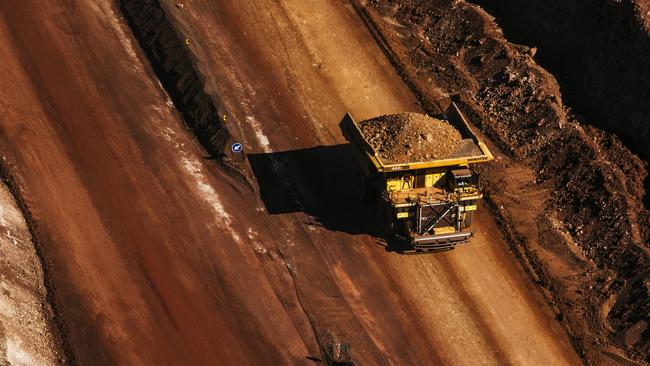Overlooked by investors, Rio, South32 royalty sales fetch princely sums
Mining giants find there is a deepening pool of buyers for global assets that have long been undervalued, but high commodity prices are delivering strong returns.

A rush of deals for royalties on resources projects is drawing attention to an asset that many investors didn’t even know about.
Elevated commodity prices have helped companies including South32, Glencore and Rio Tinto PLC raise hundreds of millions of dollars from sales of royalties that had long been on the balance sheets, but were overshadowed by their vast mining operations.
Owners of royalties get a share of revenue from a mine or oilfield, in exchange for an initial investment or as part of a deal, without having to run the operations.
A legacy of past investment and deal-making booms, global producers have dozens of royalties on their balance sheets that they believe aren’t valued by the market much.
That is changing as specialist royalty companies tap into a forecast boom for metals, such as copper that are viewed as essential to a global energy transition or gold that is a perceived hedge against inflation.
Activity has also been intensifying in the energy sector.
Sitio Royalties and Brigham Minerals, which have made substantial acquisitions in the oil-rich Permian Basin of West Texas and New Mexico this year, said this month that they had agreed to combine to become one of the largest publicly traded mineral and royalty companies in the US.
South32 recently sold a package of four base-metals royalties to London-based royalty and streaming company Anglo Pacific Group for roughly $US200m in cash and stock.
The royalties were for a mix of mines and projects owned by copper and nickel companies in the US, Australia and Chile.
“To be perfectly honest, these were royalties that probably 99 per cent of our investors didn’t know that we had, nor did they put any value on it,” South32 chief executive Graham Kerr said.
The Australia-based miner has another 36 royalties on its books, mostly for base-metals projects, that it could look to sell.
Investors say valuing royalty assets held by large miners is a tough task, in big part because those companies typically say little about them.
Matthew Haupt, lead portfolio manager at WAM Leaders, said South32 was known to own royalties, but not how many or covering what mines.
“So we couldn’t ascribe much value because we effectively didn’t know the details,” said Mr Haupt, whose fund oversees more than $US1bn in assets and owns South32 stock.
In July, a bunch of royalties held by BaseCore Metals, a joint venture between Anglo-Swiss commodities company Glencore and Ontario Teachers’ Pension Plan Board, were acquired by Sandstorm Gold, for $US525m in cash and stock.
A month later, Rio Tinto sold a royalty it held on the Cortez gold mine in Nevada, owned by a Barrick Gold and Newmont joint venture, and the nearby Fourmile project, owned solely by Barrick.
It struck the deal with Denver-based Royal Gold for $US525m in cash.
“This transaction unlocks hidden value from our portfolio and releases cash immediately,” Peter Cunningham, Rio Tinto’s chief financial officer, said at the time.
Smaller companies have also been active.
Canada’s Nova Royalty has this year signed agreements for royalties on operations run by Lundin Mining and Hudbay Minerals.
Mining executives say strong commodity prices have encouraged the flurry of deal activity. Prices for metals including copper notched record highs earlier this year, partly because of supply concerns after Russia, a key metals producer, invaded Ukraine.
Recession fears and concerns about China’s economy have weighed on prices more recently.
The timing of some deals is linked to operational milestones.
Rio Tinto obtained the Cortez royalty when it sold its 40 per cent stake in the operation to Barrick in 2008.
The royalty was due to start paying once the site had produced 15 million troy ounces of gold from 2008 onward. That is expected to happen soon, Rio Tinto said.
Marc Bishop Lafleche, Anglo Pacific’s chief executive, expects more miners to seek to turn legacy royalties and streams into cash.
“The market doesn’t recognise value with royalties or streams in that context, not because there is no value, but because they are just not daylit in the context of a substantial mining operation,” he said.
Competition for royalty assets is proving so fierce that it risks pricing some interested buyers out of the market.
One of them is Australia’s Deterra Royalties, which owns a royalty on a BHP iron-ore operation and has a mandate to buy more in bulk commodities, base metals and battery metals.
“We are seeing a lot of opportunities in that space, but haven’t seen the value to support the kind of pricing that’s needed to get them done,” said Julian Andrews, Deterra’s chief executive.
Deterra is betting that rising interest rates will lead more miners to set up new royalty arrangements to fund projects or acquisitions, as companies find it harder to raise capital in debt and equity markets.
“We think we are getting more traction,” Mr Andrews said.
– The Wall Street Journal

To join the conversation, please log in. Don't have an account? Register
Join the conversation, you are commenting as Logout